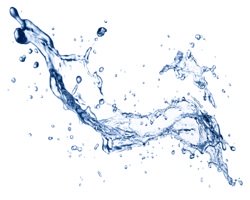Composting Toilet
Conserving Water is just one of the plusses.

Switching to a waterless toilet eliminates the need for septic tanks and fields.
No black water = no septic treatment.
Now, instead of human waste being a burdensome material requiring millions of gallons of precious fresh water and intensive sanitation processes, it becomes a productive resource that provides a high nutrient medium to trees and ornamental gardens.
Compost Toilets and Water
If your toilet was installed before 1994 it probably uses 13 or more litres (3 gallons) of pristine water per flush.

In one year a family of 4 (at 5 flushes each per day) will flush 95,000 litres of water that's almost 25,000 US gallons (over 20,000 Imperial gallons).
A shabby way to treat a precious resource that is essential for the continuation of life on the planet.
A low flow toilet uses on average 1.5 gallons of water per flush. For a family of 4 that translates into well over 10,000 gallons of fresh water per year... flushed down the toilet.
To put things into perspective that same family will drink about 2,700 litres (730 gallons) in a year.
Even with a low flow toilet, that's 14 times more water being flushed down the toilet than the human population drinks. Yikes!Types of compost toilets
Self Contained Composting Toilet.
The self contained models are simple to install and as the name implies they are toilet and composter combined. The structure itself is the composter. A tray in the bottom. collects the finished compost. Often a handle is incorporated into the design for the purpose of turning the contents which encourages oxygenation - a necessary component of the composting process. The self contained variety is easier to install and some models need to be plugged in. Self contained models have a catchment tray at the bottom that will need to be emptied periodically.Remote.
Remote models (also referred to as central or under floor) are usually installed during home construction or renovations. They are a more involved system that requires a containment unit below where the toilet is installed - usually in the basement or accessible underfloor space. The contents of the toilet are directed to this space for management. This type of composter toilet looks surprisingly...toilet like and smaller than the self contained varieties because most of the workings are situated somewhere beneath the floor.Electric
Plug in electric models are available from most manufacturers. Some users find that there are benefits to the electric models that make the system more attractive. Circulating and venting air is certainly a desireable outcome and providing a consistent heat level (heat being an essential component to the aerobic composting process) encourages a more rapid breakdown of waste. There are also 12V models available.
On the other hand, adding electricity to an otherwise self sufficient fixture seems to be a step backward. Solar may be the solution. Research is underway.Non Electric
Non electric models are available and are a little trickier to manage. The balance between oxygen, moisture and heat must be more carefully controlled by the "toilet captain".Solids Only or Both
Some compost toilets are for only solid waste (routing urine to another collection chamber) and others are for both. As a general rule, if urine is collected in your compost toilet you will need more absorbent material to keep the moisture level at the appropriate balance. When urine is separated out it is then, generally, diluted for use as a high nitrogen supplement for plantings - or thrown overboard as our cruising friends do when living on the boat.
How to Use a Composting Toilet
For the most part there is no difference in how the toilet is used until you come to the "flushing" part.
With a compost toilet, after you "go" a small amount (2 handfuls) of dry organic material is sprinkled over the contents. This material absorbs excess moisture and therefore reduces odour. The material can consist of sawdust, peat, coco coir, shredded paper, chopped dried leaves, chopped straw or hay.
Whatever cover material you choose remember that the finer it is the less loft it has. Loft (or fluffiness) allows air to circulate through the material which isn't what you want in a cover material. The finer the product the better coverage and odour control it will have.
A bucketful of the cover product must always be available beside the toilet.
Choosing Cover materials for the Composting Toilet
Cover materials are the dry, organic materials that are used to cover the excrement. Covering is a necessary part of using a compost toilet for moisture control, odour management and to give the product the proper balance and bulk for the composting process.
Cover product should have a fine, consistency for the best results. When considering the environmental impact of one material over another think about accessibility, availability in your area (local products have less negative impact than products that are transported over distances) and renewability.
Factor in issues like transportation and packaging and processing methods when choosing your cover product. It's possible that seasonal changes will make different products available in your location at different times of the year.
Following are some choices of cover material:
Sawdust
Sawdust works well as a cover product and can be a good choice if you live in an area where sawdust is available without the need to transport it over a distance. Sometimes you can get it free from local sawyers. Due to the loft of wood savings and chips they tend to not trap the odour as well as sawdust. Wood is a renewable resource when properly managed and composting is an environmentally responsible way of using the byproduct (sawdust) of sawmills.Peat Moss
Peat is a renewable resource and although there has been a great deal of to-do about peat our research thus far indicates that peat harvesting is managed in a way that allows for the regeneration of the crop.Coco Coir
Coconut coir is the dried and shredded fibrous outer shell of the coconut fruit. Very renewable and environmentally benign if it is produced in close proximity to your location. Choose the powdered coco coir for best coverage.Shredded Newsprint
Junk mail, newspaper, cardboard. Some people have luck with shredded paper products and composting at least returns them to the earth in a productive way.Shredded Dry Leaves
Shredding the leaves makes them less lofty and provides better odour control. They must be dry in order to benefit the composting toilet system.Chopped Straw or Hay
If you live in or near farm country try hay or straw. Chopping it makes a product with less loft for better coverage.Specially Designed Products
There are cover products on the market that are designed or packaged especially for use in composting toilets.
Follow the directions or guidelines of your toilet manufacturer if yours is a ready made model. If you're making your own composting toilet there is a wider variety of cover materials you can try.
The amount you use is determined by the nose. Generally, 2 handfulls should cover the deposit leaving no discernible odour. If you need much more than that to get rid of the smell, try another product. The container will fill up too fast if you're using a lot of cover and you'll be forever emptying the composting toilet.
Toilet paper goes in to the composter as do paper towels and the rolls on which they're packaged. Sanitary napkins are not great but they will compost, although they'll leave bits of plastic in your finished product that must be removed.
So how is a Composting Toilet different from an outhouse or pit latrine?
The difference is in the overall management of the excrement and, of course, the fact that a composting toilet can be installed inside the house. Outhouses and pit latrines are just a hole in the ground where the human waste accumulates without moisture or heat management. This can allow pathogens to thrive and leech into nearby groundwater and sensitive eco systems. And I probably don't have to tell you about the smell.
Composting toilets are structures that support managed aerobic decomposition and provide the essential balance of moisture, oxygen, heat and organic material to encourage the natural and rapid breakdown of the materials into beneficial elements. The aerobic (aerobic refers to "the presence of oxygen") composting process kills potential pathogens with heat while "good" bacteria and microorganisms that tolerate high temperatures work to break the contents down. And all of this with no odour.
The material recovered when the composting process is complete is a pathogen free growing medium with a high nutrient value. It looks, smells and functions like any other compost.
Managing Composting Toilet Odours
As with any aerobic compost there are certain elements that are required for success. Oxygen, organic material, heat and moisture must be kept at certain levels. Electric models may be better at maintaining the ideal heat level for composting.
If you're experiencing bad odour, the contents of your toilet are probably too wet. Add a little more absorbent, organic material. When properly managed there will be no unpleasant odour from your toilet and the finished product should smell earthy...just like dirt.
Advantages of a Composting Toilet
Conserves Water
Saves more water than a water conserving toilet. In some cases the composting toilet uses no water at all. Some models use small amounts of water.No Septic
Compost toilets require no septic features. If you're building and have not put in a septic tank or field, check with your municipal authority, You may save enough money on a septic installation to more than pay for the toilet.Turns Waste Into a Beneficial Product
The compost that your toilet produces can be buried or sprinkled around your ornamental plantings and trees. Although pathogens are eliminated due to the heat in the composting process it is not recommended that this compost be used for food crops.Throw Away the Plunger
You won't be doing any plunging in a compost toilet.No Overflows
Never again watch the water rise...and rise...and rise, to overflowing, in your toilet.
Disadvantages of a Composting Toilet
Cost
If you buy a manufactured compost toilet expect to spend $1,500 to well over $2,000 USD.Emptying
Depending on the type of composting toilet you install, a tray or container will have to be removed periodically (every two weeks to every 6 months).
View the following videos for ideas and information regarding composting toilets. We are not necessarily promoting any of these products, the videos are here for information purposes only and to show you 2 very different composting toilets.
Here's a promotional video from Envirolet
The Loveable Loo video is also a promotional video.
Although a little more work and thought go into the functioning of a composting toilet they are one of our most efficient ways to save water. We hope that one day everyone will be sitting upon a composting throne while contemplating their next green footstep.
Visitors to our Composting Toilet page may also be interested in the following pages
How to Compost

Books & Stuff

Liquid Gold: The Lore and Logic of Using Urine to Grow Plants

The Humanure Handbook: A Guide to Composting Human Manure, Third Edition

The Composting Toilet System Book - Everything you need to know

Reliance Products Luggable Loo Portable 5 Gallon Toilet

Nature's Head Dry Composting Toilet





